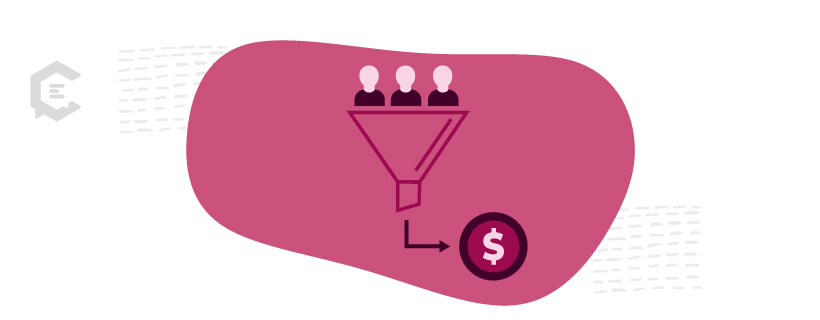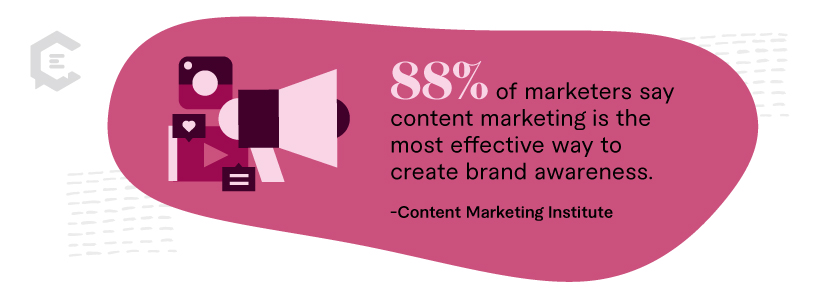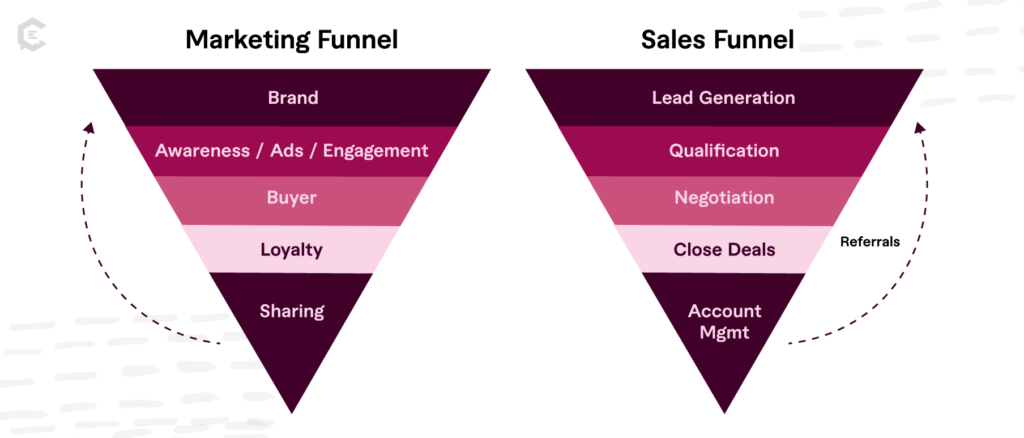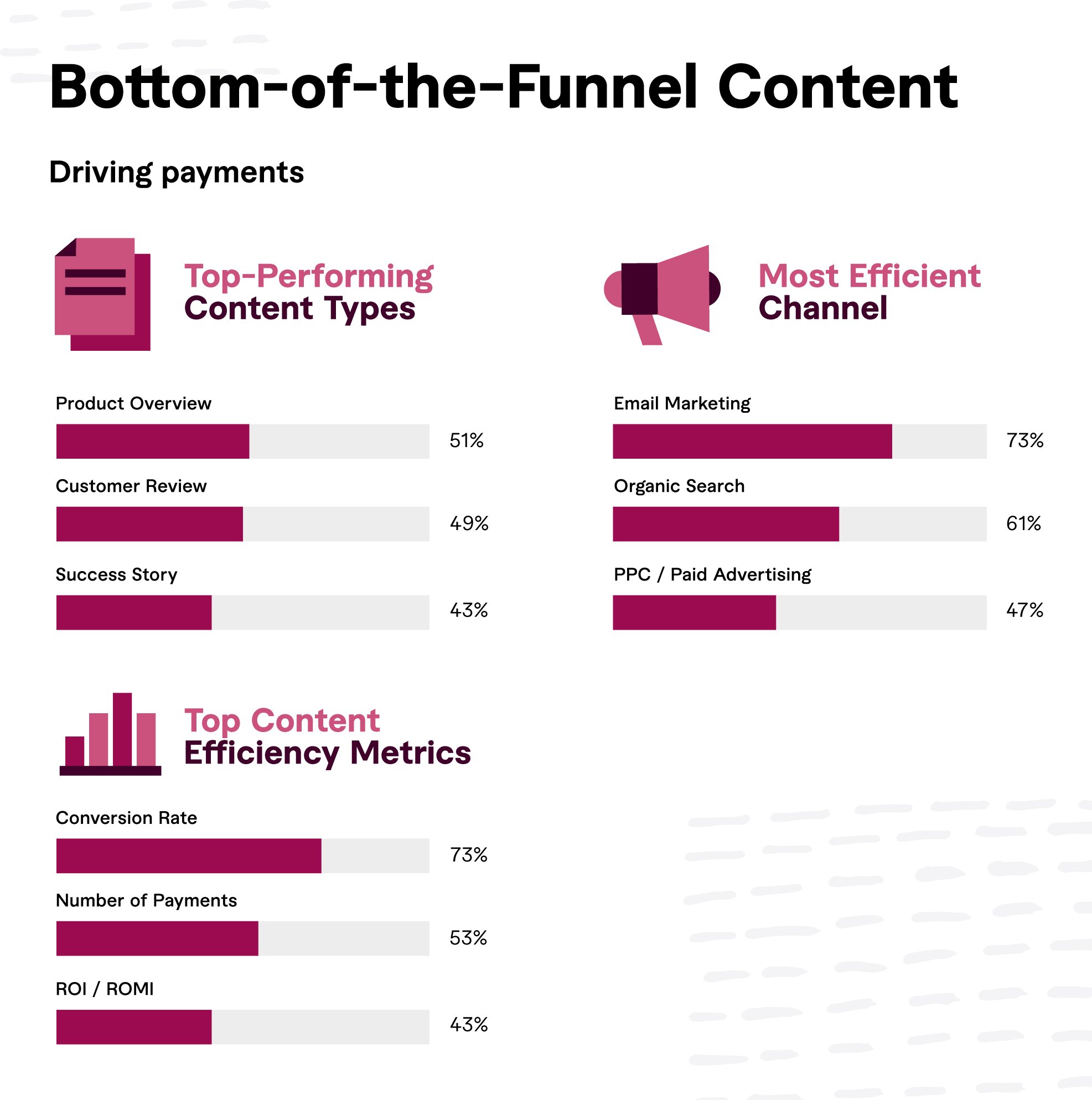Content marketers are used to working with the marketing funnel. This helps them produce the right articles, emails, eBooks, and other content based on a customer’s journey. Then there’s the sales funnel, which is often confused with the marketing funnel. Making things even more complicated, the terms thrown around in the marketing and sales funnels can be similar or the same.
From a broader perspective, the marketing funnel takes a long-term approach and seeks to build a relationship with the customer over time. Meanwhile, the sales funnel takes a short-term approach and focuses on closing the deal quickly.
Knowing details about both funnels can help you create more effective strategies and content to serve customer needs. We’ll explain that here.

The Marketing Funnel
Both funnels focus on a customer who might purchase a product or service. But their goals are slightly different.
The marketing funnel (also known as the buyer’s journey) is about the customer’s path from brand awareness to loyalty and advocacy. This requires various marketing techniques, including advertising, PR, and content marketing. The sales funnel focuses on converting a prospect into a customer. It has a more narrow purpose, that of turning a prospect into a customer.
The purpose of a marketing funnel is threefold. First, to generate interest in your brand. Second, to create a desire for the product or service. And third, to encourage some kind of action (like sharing personal information or making a purchase).
There are many ways to divide the funnel and different labels to give each stage, but marketing expert, Neil Patel divides the journey this way:
Awareness
Also called Attention, this is the first stage of the funnel, where customers gain awareness of a product or service through a blog post, an ad, a social media post, or other techniques. In fact, 88 percent of marketers say content marketing is the most effective way to create brand awareness, according to a survey by the Content Marketing Institute.
Consideration
Also called Interest, this state is where potential customers become more aware of your product or service. They want to learn more about it. They have read posts, seen videos, visited a website, or interacted in another way with a brand. This is the time to give them more focused information through infographics, case studies, eBooks, and other content.
Action
Also called Intent, this is when customers signal their interest in your product or service. They might request more information, watch a demonstration, or even add a product to an online cart.
Advocacy
At this point, the customer has made a purchase and is now using your product or service. This stage is also known as Loyalty, and it’s something you should maintain with content and support. Doing so helps a customer buy from you again. It also encourages the customer to tell others about the product/service.
As a content marketer, your role is to create content that addresses the needs of customers in each stage of the marketing funnel.
The Sales Funnel
The sales funnel comes into play at the lower end of the marketing funnel. This is where a prospect takes the necessary action to become a customer. The sales funnel consists of four stages:
Prospect
This is where the potential customer shows interest in a product or service. At the top of the funnel, your content should be informative and educational to attract prospects to your brand.
Lead qualification
Here, your content should focus on building trust and establishing your brand as a thought leader in the industry. This is where you also analyze your prospect is judged against sales criteria. The goal is to determine if they might become a viable customer.
Intent
This is when you determine the qualified lead’s intent. In other words, whether they’re interested in buying from you. This is where your content should include clear and concise calls-to-action that encourage prospects to make a purchase.
Close
At this point, your lead becomes a customer or walks away. If they’ve purchased, your focus is retention. If not, consider a nurturing strategy. Reach out every few months with emails and blogs of interest. Ongoing contact through content might change the lead from prospect to purchaser.
Marketing Funnel vs. Sales Funnel
While both marketing and sales funnels share similarities, they have different objectives. As a content marketer, you should create content to help build awareness and interest in your brand. At the same time, the content should also move potential customers through the funnel.
Typically, sales and marketing are two distinct functions. However, many businesses are merging these functions, creating an overlap between the two funnels. However your company structures your efforts, be sure your content works in tandem with the sales team’s efforts.
Here are some examples of content creation for each funnel stage:
Top of Funnel (TOFU)
At this stage, content should focus on establishing your brand, values, and benefits. With knowledge of a brand, a content marketer can make a broad play for anybody who might be interested.
Content here should be wide-ranging. It should invite the entire audience. In addition to well-produced content, SEO strategies get your brand noticed.
Middle of Funnel (MOFU)
At this stage, content is more specific to your brand. You might offer solutions to customer pain points. You might also introduce thought leadership pieces or subject-matter expertise to prove your knowledge. People here are looking for facts about products and their benefits.
Bottom of Funnel (BOFU)
At this point, your user or prospect is ready to act. That action might involve buying from you. Or it could involve a demo request. But your content efforts shouldn’t stop here. You need to continue nurturing that customer.
At this point, you might also encourage customers to share their stories and become advocates for your brand.
Keep Your Content in Focus
By creating content that addresses the needs of customers in each stage of the funnel, you can establish trust and credibility. You also build solid, ongoing relationships. This, in turn, drives business revenue.
And if you’re looking for great content or need help with your content strategy, we can help. Talk to a content strategist for more information about how to start your own content journey.







